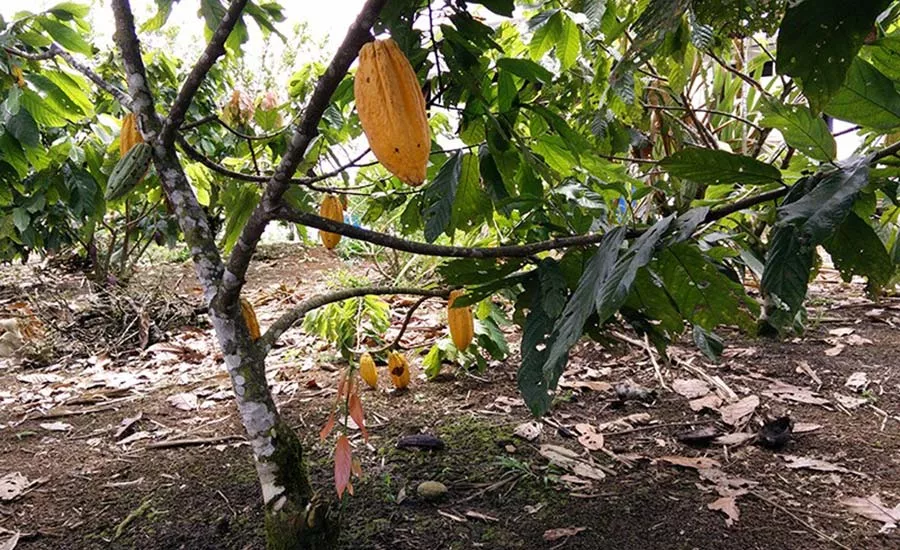Chemical contaminants
Solving the cadmium in chocolate conundrum
Unfortunately for chocolate lovers, the richer the chocolate, often the heavier dose of cadmium—and a difficult challenge for farmers to decrease naturally occurring Cd levels

The problem is that deep-rooted cacao trees take up naturally occurring cadmium in the earth’s subsoil, making it difficult to apply solutions that normally work in shallow-rooted plants such as sunflowers and corn. These particular cacao trees and pods are of the nacional variety and located on a farm in Ecuador. Photo courtesy of David Argüello
We all know that too much cadmium (Cd) in our bodies is just as dangerous as lead. Both are heavy metals, and while specific limits have been put on lead exposure (both in the air and orally), cadmium isn’t quite as well documented—at least in the U.S. The EPA places maximum allowable levels of cadmium in our drinking water as 5 parts per billion (ppb) with a goal of 0 ppb, but FDA has not set limits on safe levels of cadmium in food except to say that toddlers and infants should have no exposure at all.
For maximum allowable daily levels (MADLs) of cadmium in our food, we have to look elsewhere. California’s Prop 65 sets a limit of 4.1 micrograms (µg )/day, which is known to cause reproductive toxicity. However, a later report from the California Office of Environmental Health Hazard Assessment, Reproductive and Cancer Hazard Assessment Section, suggested that “Exposure at a level 1,000 times greater than the MADL is expected to have no observable effect.”
Excess cadmium levels in the human body can also cause kidney damage and affect the liver as it can accumulate in both organs. According to the U.S. Department of Health and Human Services, absorbed cadmium is excreted very slowly, with urinary and fecal excretion being approximately equal. The half-life for cadmium in the human body is greater than 26 years.
The European Food Safety Agency (EFSA) has set more specific limits on cadmium intake. The EFSA’s Panel on contaminants in the food chain set a reduced tolerable weekly intake (TWI) for cadmium of 2.5 micrograms per kilogram of body weight (µg/kg bw), based on an analysis of new data. The TWI is the level at which adverse effects are not expected. What does that mean in the real world? For a 150-lb person, weekly tolerable intake would equal 170 µg per week or about 24 µg per day—or roughly equivalent to one glass of my favorite cold cocoa or hot chocolate per day, which is rated at 19.6 µg per serving—as tested by the lab for As You Sow. How does your favorite chocolate indulgence rate?
And the worst of it is, EFSA’s limit not only applies to chocolate, but all foods that contain trace levels of cadmium. For example, cadmium can be found in peanut butter, peas, peanuts, beets, pretzels, sunflower seeds, and the list goes on. You can find samples in FDA’s “Total Diet Study - Market Baskets” (revised 2014-2017), an Excel file on FDA’s site. The Study includes several other elements—both necessary nutrients and dangerous elements, such as lead, arsenic and cadmium.
But a recent release from As You So isn’t the first time the subject of cadmium and chocolate has come up. FE covered a similar announcement in Tech Flash in February, 2015.
Deep rooted problem for the cacao farmer/producer
While the EU has not rejected any chocolate product at the port of entry, however, the exporters in Ecuador report that many negotiations with European buyers have been compromised, and some business deals have been left in limbo, according to David Argüello Jácome, lead researcher on a project dedicated to reducing naturally occurring levels of cadmium in cacao plants.
The research project entitled, “Surface soil liming reduces cadmium uptake in cacao seedlings but subsurface uptake is enhanced,” shows that there would be an easy fix to the problem, however, if it weren’t for one major stumbling block—the nature of how the cacao plants (actually trees) take root in the soil.
What makes the situation especially tough is that at least in South America, cacao tree farming is done mostly by mid-scale, low-income farmers, particularly in countries like Ecuador, says Jácome, who hails from Ecuador. Add to the problem: In these areas, soil concentrations of naturally occurring cadmium tend to be higher than other areas of the world.
Simple solution under normal conditions
“In order to find an effective mitigation strategy, we have to understand how a cacao plant takes up the element,” says Jácome. Traditionally in science, researchers would look at studies of other crops to see what works to prevent Cd uptake. Derived from limestone, lime is one soil additive that can help with this problem. Adding lime to the soil changes the Cd chemically so that it’s not as likely to be absorbed by the crops.
Jácome’s study found that with using soil samples from the farms in controlled pots, and testing small cacao plants in these pots, a mixture of lime in the soil could reduce Cd uptake measured in the leaves by as much as 1.7 times. Soil pH is the key property governing Cd solubility, therefore, the more acid the soli (lower pH), the more cadmium is dissolved in the soil, thus allowing more Cd to be taken into the plant. Mixing lime with the soil increases the soil’s pH, thereby reducing dissolved cadmium, and decreasing the level of available cadmium to be taken up (absorbed) in the cacao plants, where it collects in the seeds used to make chocolate.
The findings show that adding lime to both topsoil and subsoil layers in the pots decreased Cd in the cacao leaves, which was not surprising. Jácome and his fellow researchers also found that liming only the top layer also decreased cadmium. However, they discovered that when only the top layer is limed, more cadmium is taken up from roots in the bottom layer. This means that researchers and farmers cannot ignore high cadmium levels deep in soils.
Though lime was demonstrated to work in the pots, unfortunately, a cacao plant in a ten-inch pot is not analogous to how a 30-ft.-tall cacao tree grows in the real world. While most annual crops like corn or sunflowers can be grown in topsoil that is easily treated each year, cacao trees live for many years and are deep rooted, and their roots prefer not to be disturbed.
It’s a catch-22. Applying lime to surface soils near a cacao tree will result in little if any effect in the subsoil where the roots are. “It’s not possible to put lime into much of the soil without disturbing the [sensitive] roots of cacao. Farmers can only apply lime to the surface,” says Jácome.
Since liming the topsoil doesn’t have much of a positive effect on subsoil Cd levels, what strategy might work? The study suggests:
“It is necessary to search for liming materials that are able to change the chemical environment of deep soil layers. The possible changes in root activity due to a deficiency of essential nutrients such as Zn suggests that limestone + Zn supplementation could be a plausible mitigation strategy. However, more research is needed to corroborate the results of this experiment.”
References:
“Surface soil liming reduces cadmium uptake in cacao seedlings but subsurface uptake is enhanced;” David Argüello, Daniela Montalvo, Hester Blommaert, Eduardo Chavez; Erik Smolders; Journal of Environmental Quality, 19 March 2020.
“Proposition 65 Maximum Allowable Daily Level (MADL) for Reproductive Toxicity for Cadmium (Oral Route),” Office of Environmental Health Hazard Assessment (OEHHA) Reproductive and Cancer Hazard Assessment Section, May 2001.
EPA: National Primary Drinking Water Regulations, U.S. Environmental Protection Agency
EFSA sets lower tolerable intake level for cadmium in food
As You So: Searchable Chocolate Database (bottom of page)
ToxGuide for Cadmium (Cd): U.S. Department of Health and Human Services
Looking for a reprint of this article?
From high-res PDFs to custom plaques, order your copy today!








